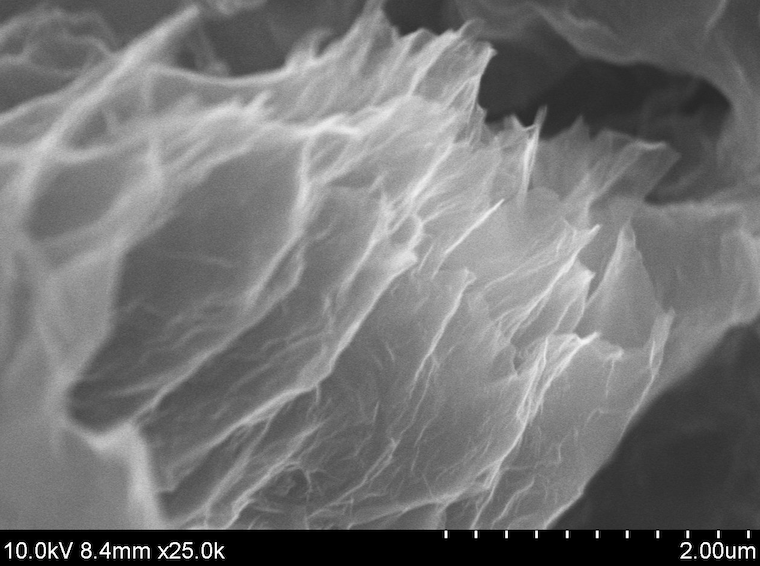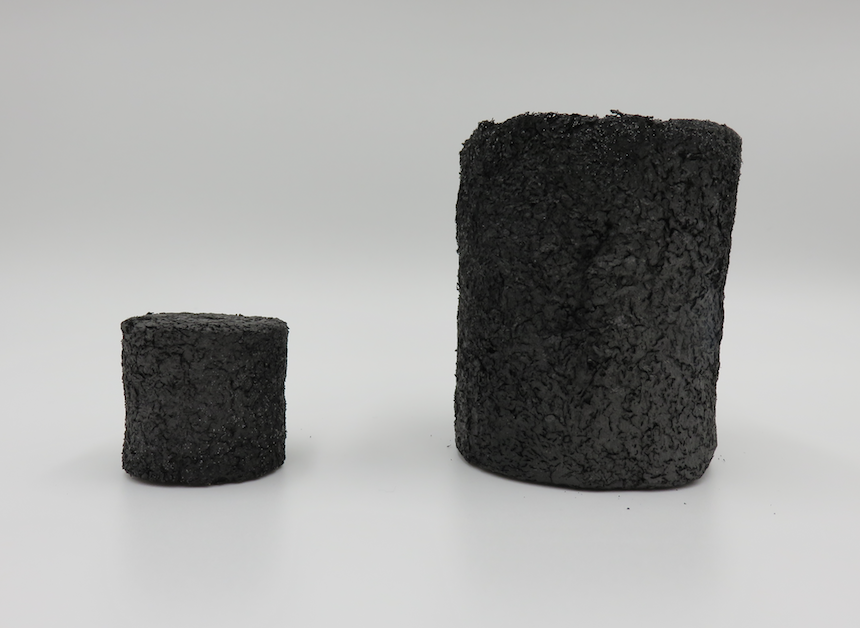Graphene Aerogel
Graphene aerogel (GA) is considered to be the lightest solid material and consists of 99.98% volume of air; it is so light that it can be balanced on even the smallest of plants. They are commonly low in density and thermal conductivity but make excellent insulators as they are almost completely comprised of gases. GAs are also very elastic but can go back to its complete, original form after being compressed. Due to its light weight, graphene has been proposed as a substitute for the somewhat rare and expensive helium.1 Helium’s density is 0.16 milligrams per cubic centimeter whereas air has a density of 1.2 milligrams per cubic centimeter, making air about 7.5 times heavier than GAs.

Figure 1. Typical SEM image of ACS Material Graphene Aerogel.
Due to a stochastic porous network, most GAs have been produced by freeze-drying in order to manipulate the microstructure for tubular graphene alignment along freezing direction. However, tailoring the macrostructures for specific applications are still being researched, i.e. separation, complete solid-state batteries, flexible electrodes and electrochemical catalyst templates.2 This has recently prompted studies on utilizing 3D printing as a way of obtaining GAs by customization. GAs have shown to be extraordinary with its light weight, high elasticity and electrical conductivity and it also makes an exceptional absorbent to clean crude oil in the water as well as supercapacitors, composites and phase transition materials. Nitrogen-doped graphene aerogels (NGAs) are also proven to be useful with its mechanical properties, lithium storage, transportation rate of Li+, electrocatalytic activity, high electrical conductivity, supercapacitor electrodes efficiency, gas adsorbents as well as good chemical stability and wettability.3 Although NGA research is still ongoing, the possibility of this material can largely adjust chemical attributes and electrical properties.4
ACS Material provides graphene aerogels that can be applied in energy storage materials, sensors, supercapacitors, flexible electronics, printable solar panels and absorption of oil and organic pollutants. There is also a nitrogen-doped graphene aerogel available where the weight percentage of nitrogen is 0.2%. ACS Material can provide GAs and NGAs in a cylindrical shape that varies by height, diameter and weight parameters all with the same density of 20.1 mg/cm3 while purity exceeds 99%. These GAs and NGAs are all prepared using the hydrothermal method.

Figure 2. ACS Material provides graphene aerogels in varying heights and diameters.
ACS Material Products:
References
1. Gorgolis, George, and Costas Galiotis. “Graphene aerogels: a review.” 2D Materials, vol. 4, no. 3, 2017, p. 032001., doi: 10.1088/2053-1583/aa7883.
2. Zhang, Qiangqiang, et al. “3D Printing of Graphene Aerogels.” Small, 10 Feb. 2016, onlinelibrary.wiley.com/doi/10.1002/smll.201503542/full. Accessed 19 Sept. 2017.
3. Yue, Chenwu, et al. “Low-Thermal-Conductivity nitrogen-Doped graphene aerogels for thermal insulation.” RSC Advances, The Royal Society of Chemistry, 11 Jan. 2016, pubs, rsc.org/-/content/articlehtml/2016/ra/c5ra23236h/unauth#!divAbstract. Accessed 13 Sept. 2017.
4. Sui, Zhu-Yin, et al. “Nitrogen-Doped Graphene Aerogels as Efficient Supercapacitor Electrodes and Gas Adsorbents.” ACS Applied Materials & Interfaces, vol. 7, no. 3, 2015, pp. 1431–1438., doi:10.1021/am5042065.